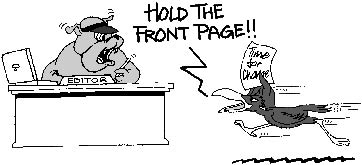4.1(c) Spinning a line
Aim
To agree on a news release, or a series of news releases, designed to interest a range of people and media.
You need
Paper and pens, a range of examples of press releases, around an hour and plenty of inspiration.
What to do
News releases need to be short, have a clear message and simple structure. Don’t get bogged down. You can give people more detail when they ask for it. The skill of writing a news release draws on the last two activities of designing a poster and preparing a leaflet or newsletter. It’s an important building block in your ability to create a clear message for a range of audiences. The group may want to draw on outside help. Be cheeky and ask the local paper or local authority press office to come and help you. This might prove a useful link anyway.
a) First, look at how news releases are done, including the Votes at 16 example below. What works? Share your findings in the group. Write down a list of do’s and don’ts to guide you now and in the future.
b) Second, agree together the main message you want to get across to a range of key audiences, such as the local newspaper, the local radio and some important council officials. This should just take a minute or two, as it’s drawing on work you’ve just done.
c) Now divide into small groups so everyone can contribute fully in preparing your own news release. Agree slightly different audiences for each group, as it will be useful to see how they compare. Use your own do’s and don’ts, the top ten tips and the example below on Votes at 16 to guide you.
Top ten tips for news releases
- White A4 – on one sheet of paper. It can be photocopied easily and information doesn’t get lost if faxed.
- Headed notepaper. This makes the news release credible and legitimate.
- Heading – News Release
- Attention – for example news desk or news editor, or, if you know people’s names add those in.
- Date and embargo – that means when the news release can be used publicly. Or you can put ‘for immediate release.’ Remember, if it is a hot story, many in the media will go public immediately anyway.
- Headline and key information, perhaps two lines in capitals. There’s no need though to be clever with the headline, as that’s the sub editor’s job.
- First paragraph containing the answers to your most important information – the five Ws: who, what, when, where and why. It must make sense on its own. Quotes are good, especially for the most important information; they are less likely to get cut.
- Any other information or more detail. Think of the news release as a pyramid: at any point the reporter, working from the bottom up, should be able to cut off successive paragraphs and it should still make sense. This means that even if your wonderful story just ends up as NIB (News In Brief), it still makes sense and gets attention.
- ENDS – this means anything you put afterwards is not for publication.
- Contacts – put contact details down, ideally of more than one person and when you can be contacted. If possible give a mobile number and say you can be reached at any time.
- Notes to editors – this allows you to give any further information about your group, background to the story, or details of things you have mentioned in the main part of the news release.
What do you think?
Review what you have produced. If you have been working in small groups, read out the others’ news releases and share your thoughts. You may need to tweak them in response to people’s comments. The group may need to agree on just one main news release to use or decide on which ones will be used where.
What next?
Just as the leaflet or newsletter provides excellent raw material for a letter, so the news release can form the basis for a short article to a local (or national) newspaper or magazine. Before moving on, take the information you have created and develop it as a short article for your local newspaper and send it to them.
NEWS RELEASE
Embargo 11am
28th January 2010
‘A REAL CHANCE TO IMPROVE BRITISH POLITICS’ VOTES AT 16 CAMPAIGN LAUNCHES
A real chance to improve British politics exists and it is up to politicians and the Government to grab it. That is the message of the Votes at 16 Campaign, which is launched today at the House of Commons.
The campaign, a coalition of groups representing young people, charities, pressure groups and political parties, wants to see the voting age lowered for all public elections and is lobbying politicians and encouraging debate among young people.
Kim Brown, a 17 year old Pupil Governor at a sixth form college, said:
“Young people like me already hold many positions of responsibility. I help to decide how millions of pounds are spent on the educational policy of my college. I am considered responsible enough to do that, yet not to have a vote in an election. This needs to change.”
Bishop Roger Sainsbury, Chair of The National Youth Agency, said:
“Young people contribute so much to British society, but often do not feel they are viewed as real citizens. We believe a massive step towards reconnecting young people with politics will be taken by lowering the voting age.” At the launch, young people will represent some of the responsible tasks that 16 and 17 year olds can undertake whilst remaining unable to vote in elections. These will include a bride and groom, car mechanic, soldier and chef.
ENDS
Notes:
1. Filming is not permitted within Committee Room 11. However, all speakers and models will be available for interview and pictures on College Green from the end of the launch event, expected to be at 11.45am.
For further information, contact: The Votes at 16 Campaign on 020 7928 1622


